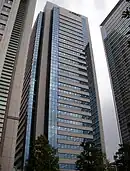N-I (rocket)
The N-I or N-1 was a derivative of the American Thor-Delta rocket, produced under license in Japan. The N stood for "Nippon" (Japan). It used a Long Tank Thor first stage, a Mitsubishi Heavy Industries-designed LE-3 engine on the second stage,[3][4][5] and three Castor SRMs.[2][6] Seven were launched between 1975 and 1982, before it was replaced by the N-II. Six of the seven launches were successful, however on the fifth flight, there was recontact between the satellite and the third stage, which caused the satellite to fail.
 The N-I rocket[1] | |
| Function | Carrier rocket |
|---|---|
| Manufacturer | McDonnell Douglas (design) Mitsubishi Heavy Industries (production) |
| Country of origin | United States (design) Japan (production) |
| Size | |
| Height | 34 metres (112 ft)[1] |
| Diameter | 2.44 metres (8.0 ft) |
| Mass | 131,330 kilograms (289,530 lb)[1] |
| Stages | 2 or 3 |
| Capacity | |
| Payload to LEO | |
| Mass | 1,200 kilograms (2,600 lb)[1] |
| Payload to GTO | |
| Mass | 360 kilograms (790 lb)[1] |
| Associated rockets | |
| Family | Delta |
| Launch history | |
| Status | Retired |
| Launch sites | LA-N, Tanegashima |
| Total launches | 7 |
| Success(es) | 6 |
| Partial failure(s) | 1 |
| First flight | 9 September 1975 |
| Last flight | 3 September 1982 |
| Boosters – Castor 2 | |
| No. boosters | 3[2] |
| Powered by | 1 TX-354-3 |
| Maximum thrust | 258.9 kilonewtons (58,200 lbf) |
| Specific impulse | 262 sec |
| Burn time | 37 seconds |
| Propellant | Solid |
| First stage – Thor-ELT | |
| Powered by | 1 MB-3-3 |
| Maximum thrust | 866.7 kilonewtons (194,800 lbf) |
| Specific impulse | 290 sec |
| Burn time | 270 seconds |
| Propellant | RP-1/LOX |
| Second stage | |
| Powered by | 1 LE-3 |
| Maximum thrust | 52.9 kilonewtons (11,900 lbf) |
| Specific impulse | 290 sec |
| Burn time | 246 seconds |
| Propellant | NTO/A-50 |
| Third stage (optional) – Star-37N | |
| Powered by | 1 solid |
| Maximum thrust | 45 kilonewtons (10,000 lbf) |
| Specific impulse | 290 sec |
| Burn time | 42 seconds |
| Propellant | Solid |

Mock up of N-1
On 29 February 1976, the second N-I conducted the only orbital launch to occur on a leap day.[7]
Launch history
| Flight No. | Date / time (UTC) | Rocket, Configuration |
Launch site | Payload | Payload mass | Orbit | Customer | Launch outcome |
|---|---|---|---|---|---|---|---|---|
| 1(F) | 9 September 1975 05:30[8] |
Tanegashima | ETS-1 (JETS-1/Kiku-1)[9] | LEO | Success | |||
| 2(F) | 29 February 1976 03:30[8] |
Tanegashima | ISS-1 (JISS-1/Ume-1)[10] | LEO | Success | |||
| 3(F) | 23 February 1977 08:50[8] |
Tanegashima | ETS-2 (Kiku-2)[11] | GTO | Success | |||
| 3rd stage used | ||||||||
| 4(F) | 16 February 1978 04:00[8] |
Tanegashima | ISS-2 (JISS-2/Ume-2)[10] | LEO | Success | |||
| 5(F) | 6 February 1979 08:46[8] |
Tanegashima | ECS-A (Ayame-1)[12] | GTO | Partial failure | |||
| 3rd stage used; Recontact between satellite and upper stage. | ||||||||
| 6(F) | 22 February 1980 08:35[8] |
Tanegashima | ECS-B (Ayame-2)[12] | GTO | Success | |||
| 3rd stage used | ||||||||
| 9(F) | 3 September 1982 05:00[8] |
Tanegashima | ETS-3 (Kiku-4)[13] | LEO | Success | |||
See also
References
- Wade, Mark. "Delta". Encyclopedia Astronautica. Archived from the original on 17 August 2013. Retrieved 3 September 2008.
- "JAXA Digital Archives". Japan Aerospace Exploration Agency. Archived from the original on 9 September 2009. Retrieved 1 October 2009.
- "N-Iロケット開発の歩み". Yukihiko Takenaka, NASDA. Retrieved 10 February 2011.
- "三菱重工 名古屋誘導推進システム製作所 事業所紹介 沿革". Mitsubishi Heavy Industries. Archived from the original on 4 July 2011. Retrieved 10 February 2011.
- "第1部 創造性豊かな科学技術を求めて 第2章 自主技術開発への展開 第3節 先導的・基盤的科学技術分野における自主技術開発の展開 2.宇宙開発". Ministry of Education, Culture, Sports, Science and Technology. Archived from the original on 15 June 2008. Retrieved 10 February 2011.
- Krebs, Gunter. "N-1". Gunter's Space Page. Retrieved 31 August 2008.
- Pearlman, Robert (29 February 2016). "Space Station Command Change Is One Giant Leap (Day) for Space History". Space.com. Retrieved 2 November 2017.
- McDowell, Jonathan. "Thor". Orbital and Suborbital Launch Database. Jonathan's Space Report. Retrieved 31 August 2008.
- "JAXA | Engineering Test Satellite I "KIKU-1" (ETS-I)". JAXA | Japan Aerospace Exploration Agency. Retrieved 16 March 2020.
- "JAXA | Ionosphere Sounding Satellite "UME" (ISS)". JAXA | Japan Aerospace Exploration Agency. Retrieved 16 March 2020.
- "JAXA | Engineering Test Satellite II "KIKU-2" (ETS-II)". JAXA | Japan Aerospace Exploration Agency. Retrieved 16 March 2020.
- "JAXA | Experimental Communications Satellites "Ayame" (ECS)". JAXA | Japan Aerospace Exploration Agency. Retrieved 16 March 2020.
- "JAXA | Engineering Test Satellite III "KIKU-4" (ETS-III)". JAXA | Japan Aerospace Exploration Agency. Retrieved 16 March 2020.
This article is issued from Wikipedia. The text is licensed under Creative Commons - Attribution - Sharealike. Additional terms may apply for the media files.

